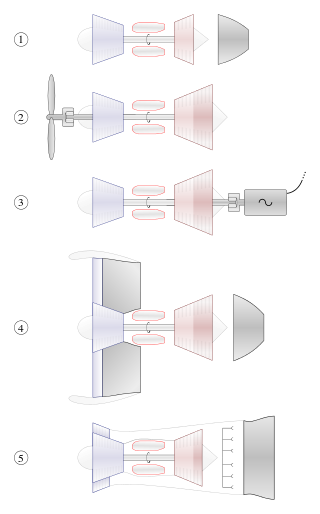
A gas turbine, gas turbine engine, or also known by its old name internal combustion turbine, is a type of continuous flow internal combustion engine. The main parts common to all gas turbine engines form the power-producing part and are, in the direction of flow:
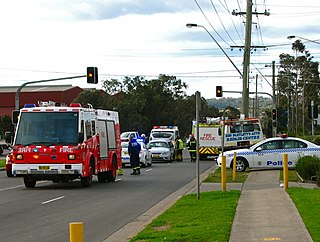
Emergency services and rescue services are organizations that ensure public safety, security, and health by addressing and resolving different emergencies. Some of these agencies exist solely for addressing certain types of emergencies, while others deal with ad hoc emergencies as part of their normal responsibilities. Many of these agencies engage in community awareness and prevention programs to help the public avoid, detect, and report emergencies effectively. Emergency services are often considered first responders, and typically have dedicated emergency vehicles.
Survivalism is a social movement of individuals or groups who proactively prepare for emergencies, such as natural disasters, and other disasters causing disruption to social order caused by political or economic crises. Preparations may anticipate short-term scenarios or long-term, on scales ranging from personal adversity, to local disruption of services, to international or global catastrophe. There is no bright line dividing general emergency preparedness from prepping in the form of survivalism, but a qualitative distinction is often recognized whereby preppers/survivalists prepare especially extensively because they have higher estimations of the risk of catastrophes happening. Nonetheless, prepping can be as limited as preparing for a personal emergency, or it can be as extensive as a personal identity or collective identity with a devoted lifestyle.

Homebuilt machines are machines built outside of specialised workshops or factories. This can include different things such as kit cars or homebuilt computers, but normally it pertains to homebuilt aircraft, also known as amateur-built aircraft or kit planes. Homebuilt aircraft or kit cars are constructed by amateurs. Homebuilt computers have been built at home for a long time, starting with the Victorian era pioneer Charles Babbage in the 1820s. A century later, Konrad Zuse built his own machine when electromechanical relay technology was widely available. The hobby took off with the early development of microprocessors and, since then, many enthusiasts have constructed their own computers. A homebuilt vehicle is a wider concept than a kit car. A homebuilt vehicle is a motor vehicle built by an individual instead of a manufacturer. These machines may be constructed "from scratch", from plans, or from assembly kits. Outside of the United States people wishing to build such complex machinery often have no professional networks to rely on for spare parts, plans, or advice in the matter and therefore have to rely on their ingenuity and intuition in order to build a machine that works.

A dispatcher is a communications worker who receives and transmits information to coordinate operations of other personnel and vehicles carrying out a service. Emergency organizations including police departments, fire departments, and emergency medical services departments as well as civilian organizations such as motorcycle couriers, taxicab providers, trucking companies, railroads, bus systems, and public utility companies, use dispatchers to relay information, direct personnel, and coordinate their operations.

A survival kit is a package of basic tools and supplies prepared as an aid to survival in an emergency. Civil and military aircraft, lifeboats, and spacecraft are equipped with survival kits.

The Military Auxiliary Radio System (MARS) is a United States Department of Defense sponsored program, established as a separately managed and operated program by the United States Army and the United States Air Force. The United States Navy-Marine Corps program closed in 2015. The program is a civilian auxiliary consisting primarily of licensed amateur radio operators who are interested in assisting the military with communications on a regional and national level when access to traditional forms of communication may no longer be available. The MARS programs also include active duty, reserve, and National Guard units; and Navy, Marine Corps units.
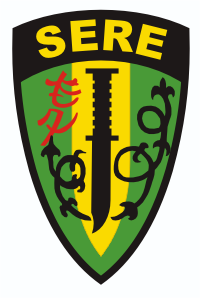
Survival, Evasion, Resistance, and Escape (SERE) is a training concept originally developed by the United Kingdom during World War II. It is best known by its military acronym and prepares a range of Western forces to survive when evading or being captured. Initially focused on survival skills and evading capture, the curriculum was designed to equip military personnel, particularly pilots, with the necessary skills to survive in hostile environments. The program emphasised the importance of adhering to the military code of conduct and developing techniques for escape from captivity. Following the foundation laid by the British, the U.S. Air Force formally established its own SERE program at the end of World War II and the start of the Cold War. This program was extended to include the Navy and United States Marine Corps and was consolidated within the Air Force during the Korean War (1950–1953) with a greater focus on "resistance training."
A mode of transport is a method or way of travelling, or of transporting people or cargo. The different modes of transport include air, water, and land transport, which includes rails or railways, road and off-road transport. Other modes of transport also exist, including pipelines, cable transport, and space transport. Human-powered transport and animal-powered transport are sometimes regarded as distinct modes, but they may lie in other categories such as land or water transport.
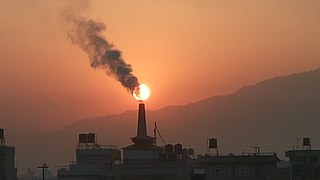
Noise control or noise mitigation is a set of strategies to reduce noise pollution or to reduce the impact of that noise, whether outdoors or indoors.

R. v. Perka, [1984] 2 S.C.R. 232 is, along with R v Latimer, a leading Supreme Court of Canada decision on the criminal defence of necessity.
An emergency service unit (ESU), alternatively emergency service detail (ESD) or emergency service squad (ESS), is a type of unit within an emergency service, usually police, that is capable of responding to and handling a broader or more specific range of emergencies and calls for service than regular units within their organization, such as rescue, emergency management, and mass casualty incidents. They are similar to police tactical units, fire department technical rescue, and incident response teams in other emergency services and organizations, and often have similar or overlapping roles; the term is also used synonymously for these units, or as a catch-all for units that combine multiple disciplines and roles under one banner.
Mount Hebo Air Force Station is a closed United States Air Force General Surveillance Radar station. It is located 5.2 miles (8.4 km) east-southeast of Hebo, Oregon, located at the top of 3,154-foot (961 m) Mount Hebo. It was closed in 1980.
The following outline is provided as an overview of and topical guide to military science:

Human power is the rate of work or energy that is produced from the human body. It can also refer to the power of a human. Power comes primarily from muscles, but body heat is also used to do work like warming shelters, food, or other humans.
The Association for Uncrewed Vehicle Systems International, also known as AUVSI, is an international nonprofit organization dedicated to advancing the unmanned systems and robotics industry through communication, education, and leadership.

The defense industry of Turkey has a long history, dated from the Ottoman Empire, and has changed several times during the Republic period.
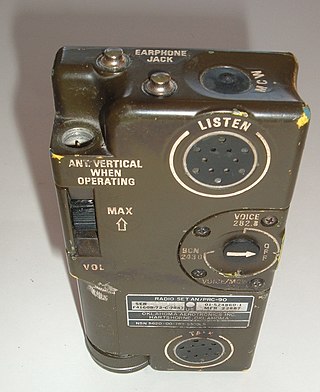
Survival radios are carried by pilots and search and rescue teams to facilitate rescue in an emergency. They are generally designed to transmit on international distress frequencies. Maritime systems have been standardized under the Global Maritime Distress Safety System. Civil and military organisation's utilized different frequencies to communicate and no infringement on either sector would take place. For emergencies involving civilian aircraft, the radio frequency used is VHF 121.5 MHz and for military aircraft incidents, the frequency used is UHF 243 MHz.

The Baltimore City Fire Department (BCFD) provides fire protection and emergency medical services to the city of Baltimore, Maryland, United States. Founded in 1797 and established in 1859, the Baltimore City Fire Department covers an area of 81 square miles (210 km2) of land and 11 square miles (28 km2) of water, with a resident population of over 640,000 and a daytime population of over 1,000,000. The BCFD responds to approximately 235,000 emergency calls annually. There are two International Association of Fire Fighters (IAFF) locals; IAFF 734 for firefighters and IAFF 964 for officers.
An emergency locator beacon is a radio beacon, a portable battery powered radio transmitter, used to locate airplanes, vessels, and persons in distress and in need of immediate rescue. Various types of emergency locator beacons are carried by aircraft, ships, vehicles, hikers and cross-country skiers. In case of an emergency, such as the aircraft crashing, the ship sinking, or a hiker becoming lost, the transmitter is deployed and begins to transmit a continuous radio signal, which is used by search and rescue teams to quickly find the emergency and render aid. The purpose of all emergency locator beacons is to help rescuers find survivors within the so-called "golden day", the first 24 hours following a traumatic event, during which the majority of survivors can usually be saved.